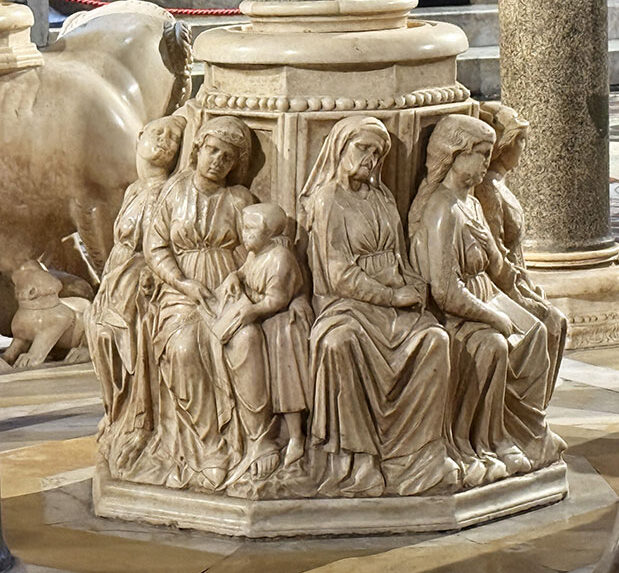
This is a pillar on a pulpit at the cathedral in Siena, Italy.
By Patrick Schmadeke
Evangelization in the World Today

Last month my wife and I were in Siena, Italy. The trip was part work, part 10-year wedding anniversary trip, part trying to learn more about Catherine of Siena (the namesake of our second child), part meet-up with friends. I didn’t expect that I would leave Siena with a new favorite building: the cathedral.
This is not because of the sheer enormity of the cathedral (though it is massive), nor because of the mesmerizing alternation of white and green marble on both the outside and inside (though that is amazing too), but rather, because of the theology of the building.
This medieval cathedral is not a generic church that could exist in any city. Its art and architecture reflect the place itself. At the entrance, laid into the marble floors of the cathedral, is a mosaic of Romulus and Remus suckling the she-wolf. By legend it was Romulus and Remus who founded Rome; it was two sons of Remus, Aschius and Senius, who founded Siena. Other features that make the cathedral unique to Siena include a statue and fresco of Catherine of Siena and another commemorating Pope Pius III, who had been Archbishop in Siena prior to his elevation to the papacy.
Fifty-six marble panels carpet the entire floor of the cathedral, depicting various biblical stories, allegories, and sibyls. Work to complete the floor spanned the 14th through 19th centuries, and was completed almost entirely by Sienese artists. Techniques varied from panel to panel. Eventually, artists came to use a stunning array of gold, white, red, gray, and brass colors to achieve depth and shadows in the floor. This art is not only impressive, it is immersive. Depictions of Moses, Elijah, David and others bring the Old Testament stories beneath one’s feet, literally to life, for a largely illiterate community. Even richer, for me, however, is how the cathedral fuses together theology with philosophy.
Our sauntering first took us to the octagonal pulpit, crafted by Nicola Pisano and his team in the 1260s. By my count, it takes at least 14 steps to ascend this huge structure. Beyond the impressive panels depicting salvation history on each side, what most stimulated my imagination is its supporting structure: a series of columns with one at the center depicting the seven liberal arts — grammar, dialectic, rhetoric, philosophy, arithmetic, music and astronomy. In our age of AI companies promoting themselves as capable of generating homilies, imagine a world in which the central supporting structure of preaching is formation in the liberal arts.
Our second stop was around the altar. What I found most riveting here was the presence of the four cardinal virtues inlaid in the marble floor: temperance, prudence, justice, and fortitude. This is instructive: the Eucharist can galvanize the community in virtue, if we let it.
We then came to the midway point of the central aisle where we found the Wheel of Fortune. The wheel reminds the viewer that fate is never stable. We should neither delight in good fortune, nor grieve in bad fortune; for fortune is fickle. Whether the wheel has us on the up-and-up, or whether it has us down-and-out, we come to the Eucharistic table as a community, leaving our fortunes behind, dying and rising in the eucharist with and for one another.
Our last stop was in the baptistry, built in the early 1300s behind the church. Skulls are laid into the marble floor as one enters the baptistry, reminding us of our dying and rising in Christ through baptism. Frescoes in the ceiling above the baptismal font illustrate articles of the Apostles Creed. These images, painted between 1447-1450 by Lorenze di Pietro, remind the catechumen of the essential elements of the faith. In this space, as one is cleansed by water, one is embraced by the faith.
During our visit we enjoyed aperitivo with friends in the shadows of the Basilica de Santa Caterina — a space with its own courageous and long-lasting story to tell. From our view, the cathedral was nestled upon the hilltop across the valley. Just as the Sienese artists depicted depth and shadow with color on the Cathedral marble floor, the setting sun illuminated the dome, bell tower, upper portions of the cathedral’s façade, and city-scape. Bell towers across Siena chimed to mark the 6 o’clock hour. The peace of this hour matched the silent witness of the cathedral architecture. The cathedral opens the mind and heart, inviting the viewer into a story worth following.
(Patrick Schmadeke is director of evangelization for the Diocese of Davenport.)








